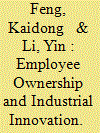|
|
|
Sort Order |
|
|
|
Items / Page
|
|
|
|
|
|
|
| Srl | Item |
| 1 |
ID:
183637


|
|
|
|
|
| Summary/Abstract |
Advanced semiconductors and telecommunication technologies are both critical high-tech industries for China's success in indigenous innovation, defined as the process of improving upon technologies learned abroad and generating sophisticated technologies indigenously. Leading Chinese companies in both industries, including Huawei in telecom equipment and Semiconductor Manufacturing International Corporation (SMIC) in semiconductor fabrication, have been thrust into geopolitics because of their success as innovative enterprises. Examining Huawei and SMIC's processes of indigenous innovation in the historical context of government policies and industry development paths, this article argues that strategic innovation investment and sustained organizational learning in innovative enterprise, enabled by autonomy in decision making, are the key to successes in indigenous innovation. This industry study may have implications for the developing countries in rethinking and adjusting their policy practices and theories of innovation transition.
|
|
|
|
|
|
|
|
|
|
|
|
|
|
|
|
| 2 |
ID:
177624


|
|
|
|
|
| Summary/Abstract |
Huawei Technologies, the Chinese telecommunication technology giant that was put into the U.S. government's Entity List from May 2019, has become a contested issue in the emerging U.S.-China technology rivalry. In particular, the U.S. government and Western academics have viewed Huawei's unique employee ownership as an opaque structure subject to the influence of the Chinese state. In this article, we draw on a variety of data sources, including historical archives, interviews with corporate executives, and official government data, to provide a full account of Huawei's employee ownership, including its history, structure, and function. We examine popular misconceptions of Huawei's innovative capabilities and corporate structure, showing that these arguments have generally lacked awareness of the innovation process and corporate governance in the historical context of China's reform. Based on a theory of innovative enterprise, we provide an explanation on how employee ownership has helped Huawei to incentivize a massive engineering workforce and build an innovative organization to succeed in the competitive high-tech industries.
|
|
|
|
|
|
|
|
|
|
|
|
|
|
|
|
| 3 |
ID:
181848


|
|
|
|
|
| Summary/Abstract |
This article studies state capacity in innovation policy from the perspective of government knowledge. In the market-oriented reform, the Chinese state has changed its way to coordinate technological development from the planning approach such as administrative orders and plan targets to the market approach such as innovation subsidy policies. Through case studies and regression analysis, this research finds that China's state capacity in its innovation subsidy policies is highly limited in all because the government knowledge is too thin to achieve the state's goals. However, its policy performance is different between the two categories of innovation subsidy policies. Policies that use qualification certification as the main instrument rely on grassroots governments as the main executors, and they do not have industry-specific human resources and have failed to make use of potential connecting network with the industry. Policies that use project contracting as the main instrument do fare better. The central government, as the main policy maker and performer, has industry-specific personnel and has made better use of the penetration network of local governments.
|
|
|
|
|
|
|
|
|
|
|
|
|
|
|
|
| 4 |
ID:
183636


|
|
|
|
|
| Summary/Abstract |
In a volatile geopolitical environment and evolving national policy, the Chinese system of industrial innovation is going through a period of profound change. The success of Chinese industrial corporations in responding to these changes through investment in innovation will have far-reaching implications for the future of China and the world. Based on studies of five industries, including telecom-equipment, semiconductors, biopharmaceuticals, high-speed railways, and low-speed electric vehicles, the papers in this special section explore the landscape of Chinese industrial innovation in terms of the sources, directions, and models of innovation. We then consider the policy implications for transforming China's industrial innovation in this new era, with a view toward achieving "common prosperity."
|
|
|
|
|
|
|
|
|
|
|
|
|
|
|
|
|
|
|
|
|